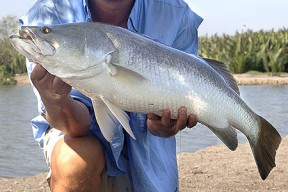Lates calcarifer
Barramundi
Classification
Latidae
Distribution
Widely distributed around Asia and Australia. It occurs eastward from the Persian Gulf through India, Thailand, China and Japan, and then southward through Indonesia and Australia.
Habitat
Found in a wide variety of habitats, from freshwater rivers and lakes, to brackish and marine coastal waters. It tends to prefer areas with submerged cover, such as logs and rocky overhangs.
Maximum Standard Length
80″ (200cm), and up to 60kg in weight.
Aquarium SizeTop ↑
A truly humongous tank (or pond) would be required by an adult specimen. Something in the region of 20′ x 6′ x 10′ should be considered a bare minimum. A tank of this size would hold over 30,000 litres of water!
Maintenance
Speaking hypothetically, decor would not be critical. Obviously an enormous filtration system would be needed to cope with the massive amounts of biological waste a fish of this size produces. The species is very tolerant of saline conditions, and could be kept in a brackish or marine system if necessary.
Water Conditions
Temperature: 59-82°F (15-28°C)
pH: 7.0-8.5
Hardness: 10-30°H
Diet
Highly piscivorous in nature, juvenile captive specimens have been known to accept prawns, lancefish etc. An adult fish would need large amounts of whole fish such as trout. Keeping one of these fully fed would certainly be an expensive proposition. Larger specimens should be fed with care as they tend to strike quite savagely when feeding.
Behaviour and CompatibilityTop ↑
Peaceful with anything it can’t fit into its mouth. This doesn’t actually leave many available species that it can be housed with in the long term though. Young specimens have been successfully cohabited with tankmates such as Cichla sp., Datnioides sp., arowana and tankbusting catfish.
Sexual Dimorphism
Unknown.
Reproduction
Surely impossible in aquaria, even more so when you consider the fish are diadromous in nature; migrating from fresh to brackish or marine water to spawn. Interestingly all individuals are born as and spend the first few years of life as males, before some change sex to become female.
NotesTop ↑
This species is included purely because there have been an alarming number of juvenile fish showing up recently in some aquatic stores and as a result, in hobbyists tanks. This fish is simply not suited to captive life in any respect. To know that it’s one of the most sought after sport fish in Australia should tell you all you need to know about it. Although undeniably attractive when juvenile, please don’t be tempted to buy if you see these for sale. Housing one for life is beyond the reach of even most public aquaria. Sadly owning this species and others like it seems to be fashionable in some fishkeeping circles at the moment, with some aquarists even viewing them as a status symbol. Thankfully it’s now banned from import (into the UK at least) and will hopefully disappear from the hobby altogether as a result. It’s a prized food fish in many of its native countries, and in Australia is considered the most commercially important freshwater species.


